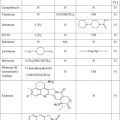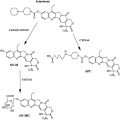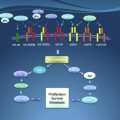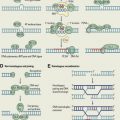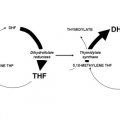Identification of driver mutations in growth related protein kinases, especially tyrosine kinases, has led to clinical development of an array of tyrosine kinase inhibitors in various malignancies, including lung cancer. Improved understanding of tyrosine kinase biology has led to faster drug development, identification of resistance mechanisms, and ways to overcome resistance. This review discusses the clinical data supporting the use and practical aspects of management of patients on epidermal growth factor receptor and anaplastic lymphoma kinase tyrosine kinase inhibitors.
- •
Erlotinib is approved for use as monotherapy in locally advanced or metastatic non–small cell lung cancer (NSCLC) after failure of at least one prior chemotherapy and as maintenance for patients whose disease has not progressed after 4 cycles of platinum-based first-line chemotherapy.
- •
Presence of epidermal growth factor receptor (EGFR)-activating mutation is the strongest predictor of response rates and progression-free survival in patients with NSCLC treated with EGFR–tyrosine kinase inhibitors (TKIs), and it is recommended that all patients who are considered for first-line therapy with an EGFR-TKI undergo tumor testing for presence of EGFR mutations.
- •
The most common adverse reactions with EGFR-TKI are rashlike events and diarrhea, although uncommonly, life-threatening events like interstitial lung disease are observed.
- •
Crizotinib is approved for treatment of patients with locally advanced or metastatic anaplastic lymphoma kinase translocation (ALK)-positive NSCLC.
- •
The most commonly reported adverse events with crizotinib are nausea, diarrhea, vomiting, edema, and constipation.
- •
Clinical development of other growth-related protein kinase inhibitors and efforts to understand the biology of resistance to EGFR and ALK tyrosine kinase inhibition and strategies to overcome resistance are ongoing.
Lung cancer accounts for more deaths than does any other cancer in both men and women in the United States and worldwide. Non–small cell lung cancer (NSCLC) constitutes approximately 85% of all lung cancers, and 40% of patients with newly diagnosed NSCLC have metastatic disease. In patients with advanced NSCLC, as well as those who relapse after initial definitive therapy, platinum-based systemic chemotherapy improves survival, quality of life, and symptom control compared with supportive care. However, despite the addition of new therapies, the median overall survival (OS) of patients with advanced NSCLC is approximately 1 year and only 3.5% of patients survive 5 years after diagnosis.
Protein kinases play a crucial role in signal transduction, cellular proliferation, differentiation, and other regulatory mechanisms. The identification of growth-related protein kinases, especially tyrosine kinases, as a therapeutic target for cancer and adenosine triphosphate (ATP)-binding domain of tyrosine kinases as an attractive target for drug design have led to clinical development of an array of tyrosine kinase inhibitors (TKIs) in various malignancies, including lung cancer. In recent years, clinical application of these agents, coupled with understanding of NSCLC as a heterogeneous disease with several genetic subsets, has led to median survival extending to beyond 30 months in selected patients with advanced NSCLC. This review discusses TKIs in lung cancer, focusing on clinical evidence supporting the use and practical aspects of management of patients using inhibitors of 2 of the most extensively studied tyrosine kinases in the recent past: epidermal growth factor receptor (EGFR) and anaplastic lymphoma kinase (ALK).
Epidermal growth factor receptor tyrosine kinase inhibitors
EGFR (HER1, ErbB1) is a member of a family of transmembrane glycoprotein receptors that also includes HER2, HER3, and HER4 (also known as ERBB2, ERBB3, and ERBB4, respectively). In normal cells, ligand binding to the extracellular domain of EGFR induces receptor homodimerization and heterodimerization, which leads to conformational changes in EGFR, activation of the intracellular tyrosine kinase domain, phosphorylation of specific tyrosine residues, and recruitment of a range of proteins, which activates downstream signaling pathways including mitogen-activated protein kinase (MAPK), phosphatidylinositol-3-OH kinase (PI3K/Akt), and the signal transducer and activator of transcription (STAT)-mediated pathways. In NSCLC, EGFR protein is expressed in 50% to 90% of cases, and EGFR-associated signaling pathways are frequently dysregulated. The 2 major approaches to EGFR inhibition are the use of small-molecule inhibitors of intracellular tyrosine kinase domain and monoclonal antibodies, which block the extracellular domain of the receptor. Gefitinib and erlotinib are orally administered EGFR-TKIs, which compete with ATP for binding to the tyrosine kinase domain.
Clinical Trials of EGFR-TKIs in Lung Cancer
Results of initial phase II studies of EGFR-TKIs in previously treated patients with advanced NSCLC of all histologies appeared very promising. IDEAL 1 and IDEAL 2, both randomized, double-blind, phase II, multicenter trials, which evaluated 250 mg or 500 mg of continuous oral gefitinib in more than 400 patients, demonstrated a tumor objective response rate (ORR) of 9% to 19%, median survival of 6 to 8 months, and improvement in lung cancer symptoms. There was no difference in ORR, time to progression, and median survival between the 2 doses, and the 500-mg dose level was associated with more adverse events. In May 2003, based on data from IDEAL 2 trial, gefitinib (250 mg) received accelerated approval by the US Food and Drug Administration (FDA) for monotherapy for patients with advanced NSCLC after failure of both platinum-based chemotherapy and docetaxel. A smaller phase II trial of continuous oral erlotinib in 57 patients also showed response rates of 12.3%, median survival of 8.4 months, and tumor-related symptom improvement.
However, in previously untreated patients with advanced NSCLC of all histologies, randomized trials of combination of EGFR-TKIs with conventional chemotherapy showed no improvements in OS over chemotherapy alone. The INTACT 1 and INTACT 2 trials demonstrated no survival benefit of concurrent administration of gefitinib with either cisplatin/gemcitabine or carboplatin/paclitaxel, respectively, compared with chemotherapy alone. Similarly, the TALENT and TRIBUTE trials, which combined erlotinib with cisplatin/gemcitabine or carboplatin/paclitaxel, respectively, showed no survival benefit compared with chemotherapy alone.
In chemotherapy pretreated NSCLC patients, 2 large multicenter phase III trials that evaluated monotherapy with EGFR-TKIs yielded divergent results. The BR.21 trial randomized 731 patients with all histologies of advanced NSCLC who had received 1 or 2 prior chemotherapy regimens in a 2:1 ratio to receive either erlotinib or placebo. Despite a high proportion of patients who had received 2 or more prior chemotherapies (50%), OS, the primary end point of the study (6.7 months vs 4.7 months; hazard ratio [HR] 0.70; P <.001), ORR (8.9% vs <1%; P <.001), and improvements in symptoms favored the erlotinib group. By contrast, a similarly designed ISEL trial of 1692 patients found no significant survival advantage for gefitinib either in the overall population of NSCLC patients who had received 1 or 2 prior chemotherapy regimens or in the adenocarcinoma coprimary population. Although the 2 trial populations were similar in many respects, a higher proportion of the ISEL trial population had not responded to prior chemotherapy regimen (38% vs 18%) and had progressive disease (45% vs 28%) compared with the BR.21 population. Another possible explanation of the discordant results was the relatively low drug dosing in the ISEL trial, which used one-third of the maximum tolerated dose (MTD) of gefitinib (250 mg) compared with the MTD of erlotinib (150 mg) used in the BR.21 trial. As a result of these postmarketing phase III results, in 2005 the FDA restricted the use of gefitinib to patients who are currently benefiting or have previously benefited from its use.
In selected chemo-naïve patients with advanced NSCLC, 5 phase III open-label, randomized trials in East Asian patients demonstrated superior ORR and progression-free survival (PFS) when gefitinib was compared with platinum-based chemotherapy. The IPASS and First-SIGNAL trial populations were enriched to increase the likelihood of response based on clinicopathologic features, that is, never-smokers/former light smokers and adenocarcinoma histology. The OPTIMAL, WJTOG3405, and NEJ002 trial populations were molecularly defined based on the presence of EGFR-activating mutations and additionally in the case of NEJ002, absence of a resistant mutation. IPASS, which was the largest of these trials, was designed with PFS as the primary end point to assess the noninferiority of gefitinib compared with carboplatin/paclitaxel in 1217 patients. The study met its primary objective of demonstrating noninferiority and showed superiority of gefitinib for PFS (HR 0.74, 95% confidence interval [CI] 0.65–0.85; P <.001), ORR (43% vs 32.2%; P <.001), and quality of life in the overall study population. Recently reported updated survival results showed no significant difference in OS between the treatment arms in the intention-to-treat population (HR 0.90, 95% CI 0.79–1.02; P = .109) as well as in the mutation-positive and mutation-negative subgroups. One of the factors that possibly contributed to the lack of survival benefit is the high proportion of patients in the chemotherapy arm (64.3%) who received gefitinib at progression. Results of EURTAC, a phase III randomized study that compared erlotinib with platinum-based chemotherapy in chemo-naïve Caucasian patients with EGFR-activating mutations, also reported a PFS (9.4 months vs 5.2 months; HR 0.42; P <.0001), but no OS benefit of erlotinib.
In the maintenance setting, several phase III trials have demonstrated modest improvements in PFS, but no OS advantage with gefitinib or erlotinib after chemotherapy in unselected patients with advanced NSCLC. In the SATURN study (N = 884), erlotinib prolonged PFS in patients who had nonprogressive disease after 4 cycles of first-line platinum-doublet chemotherapy in the overall population as well as in the EGFR immunohistochemistry-positive subgroups. After a median follow-up more than 11 months, median PFS was longer with erlotinib than with placebo (12·3 weeks vs 11·1 week [HR 0·71, 95% CI 0·62–0·82; P <·0001]). In a prospectively planned analysis of the SATURN study, OS was significantly prolonged with maintenance erlotinib, compared with placebo (HR 0.72, 95% CI 0.59–0.89; P = .0019; median OS 11.9 vs 9.6 months, respectively) in patients who had stable disease after the first-line chemotherapy (n = 487, 55%). However, no significant difference in OS was observed in the patients who had complete/partial response (n = 394, 44%) (HR 0.94, 95% CI 0.74–1.20; P = .6181; median OS 12.5 vs 12.0 months in the erlotinib and placebo groups, respectively). The ATLAS trial, which evaluated the benefit of addition of erlotinib to bevacizumab as maintenance therapy after first-line platinum-doublet chemotherapy plus bevacizumab, also met its primary end point of improving PFS (4.76 months vs 3.75 months [HR 0.72, P = .0012]). The phase III SWOG-S0023 study, which prospectively evaluated maintenance gefitinib after chemoradiotherapy in unselected patients with locally advanced NSCLC, was suspended before completing its target accrual after an unplanned interim analysis showed inferior OS in the gefitinib arm compared with the placebo arm (HR 0.633, 95% CI 0.44–0.91; P = .013).
Based on the results of BR.21 and SATURN trials, erlotinib (150 mg) was approved by the FDA as monotherapy in locally advanced or metastatic NSCLC after failure of at least 1 prior chemotherapy regimen and as maintenance therapy for patients whose disease had not progressed after 4 cycles of platinum-based first-line chemotherapy.
Predictors of Response to EGFR-TKIs
Early trials of EGFR-TKIs in NSCLC identified the factors female sex, adenocarcinoma histology, East Asian descent, and no prior history of smoking to correlate with response to treatment. Since then, several EGFR-related biomarkers including EGFR mutation, gene copy number, and protein expression have been investigated in major clinical trials for their predictive value. EGFR-activating mutations, which are found more frequently in patients with these clinicopathologic features, have emerged as the strongest predictor of response rates and PFS in patients treated with EGFR-TKIs. EGFR-activating mutations are found in the kinase domain of the EGFR gene and comprise mostly in-frame deletions of exon 19 and L858R substitution in exon 21. In unselected NSCLC patients, EGFR mutations are found in about 10% of the population. In clinicopathologically selected patients, the incidence is about 60% in Asians and 40% in whites.
Despite the strong correlation of clinicopathologic criteria and EGFR mutations, several recent reports show that EGFR mutations rather than clinicopathologic criteria should be used to select chemo-naïve patients for EGFR-TKI use. In the IPASS trial, patients with EGFR mutations who were treated with gefitinib had remarkably high ORR (71.2%), PFS (HR 0.48, 95% CI 0.36–0.64; P <.001) and improvement in quality of life. By contrast, patients with wild-type EGFR (n = 176) treated with gefitinib had inferior ORR (1.1%), PFS (HR 2.85, 95% CI 2.05–3.98; P <.001) and OS (HR 1.38, 95% CI 0.92–2.09; not significant). The OS disadvantage of EGFR wild-type patients who were treated with gefitinib, although not statistically significant, persisted in updated survival analysis and was also observed in the First-SIGNAL study (HR 1.199, 95% CI 0.570–2.521; P = .632). A differential response to EGFR-TKIs based on the type of EGFR mutation was noted in some studies, although this could not be confirmed in others.
Practical Considerations
Toxicities
The most common adverse reactions with EGFR-TKIs are rashlike events and diarrhea. Erlotinib and gefitinib have similar toxicity profiles, but erlotinib is more toxic because its recommended dose is closer to the MTD. In the BR.21 trial, grade 3/4 rash occurred in 9% patients with a median time to onset of 8 days. A spectrum of skin, hair, and nail changes are known to occur, but the most common dermatologic manifestation is a papulopustular rash involving the face and/or upper trunk. On initiation of EGFR-TKI, all patients should be advised to use emollients, minimize sun exposure, and use sunscreens. Once skin toxicity is manifest, depending on the severity, topical or systemic glucocorticoids, antibiotics, and immunomodulators may be used. Several expert groups have issued guidelines for the grading and management of skin changes related to EGFR inhibition. In the BR.21 trial, grade 3/4 diarrhea occurred in 6% patients with a median time to onset of 12 days. Diarrhea is often mild, and loperamide may be used for symptomatic management. Most cases of rash and diarrhea are best addressed by symptomatic management and do not necessitate alteration in the course of treatment. However, in case of severe symptoms, dose modifications or treatment interruption may be necessary. In the BR.21 study, 6% and 1% of patients needed dose reduction for rash and diarrhea, respectively, and each resulted in discontinuation of erlotinib in 1% of patients.
Interstitial lung disease (ILD)-like events have been observed in patients receiving EGFR-TKIs, with an overall incidence of about 1% and a higher incidence in Japanese patients. A prospective study of Japanese patients receiving either gefitinib or chemotherapy identified older age (≥55), poor performance status, smoking, short duration since diagnosis of NSCLC, reduced normal lung on computed tomography scan, preexisting chronic ILD, and concurrent cardiac disease as risk factors for the development of ILD. Patients often present with acute onset of dyspnea, sometimes associated with cough or low-grade fever, often becoming severe within a short time. These symptoms warrant immediate interruption of EGFR-TKI and institution of supportive measures including oxygen, corticosteroids, or assisted ventilation.
Dosing
Erlotinib is used at its MTD of 150 mg daily, on an empty stomach at least 1 hour before or 2 hours after the ingestion of food. When dose reduction is necessary, the erlotinib dose should be reduced in 50-mg decrements. Gefitinib is used at 250 mg per day with or without food, a dose lower than its MTD, based on phase II data that showed similar efficacy, but less toxicity with 250 mg.
Interactions
Drugs that alter the pH of the upper gastrointestinal (GI) tract may alter the solubility of erlotinib and gefitinib, thus reducing their bioavailability. Coadministration with omeprazole, a proton-pump inhibitor, decreased erlotinib exposure by 46%. Because proton pump inhibitors affect the pH of the upper GI tract for an extended period, separation of doses may not eliminate the interaction and hence concomitant use of proton-pump inhibitors with erlotinib should be avoided, if possible. If patients need to be treated with an H2-receptor antagonist (eg, ranitidine), it should be used in a staggered manner: erlotinib must be taken 10 hours after and at least 2 hours before a dose of H2-receptor antagonist. Erlotinib and gefitinib undergo extensive hepatic metabolism, predominantly by cytochrome P (CYP) 3A4. Inhibitors (eg, ketoconazole) and inducers (eg, rifampicin) of CYP3A4 would be expected increase and decrease drug exposure, respectively. Cigarette smoking, which is known to induce many hepatic CYP450 enzymes, reduces erlotinib exposure, and patients should be advised to stop smoking.
Monitoring
Patients with hepatic impairment should be closely monitored during therapy with erlotinib and gefitinib. Dosing should be interrupted or discontinued if total bilirubin is greater than 3 times the upper limit of normal (ULN) and/or transaminases are greater than 5 times the ULN in the setting of normal pretreatment values.
Duration
Treatment should continue until disease progression or unacceptable toxicity occurs. Although accelerated progression of disease after discontinuation of TKIs has been observed in some studies, there is no evidence at this time that treatment beyond progression is beneficial.
Erlotinib versus gefitinib
As already discussed, erlotinib is dosed at its MTD whereas gefitinib is not, and the area under the curve (AUC) of erlotinib at the standard dose is 7 times larger than that of gefitinib. In trials comparing first-line conventional chemotherapy with EGFR-TKIs, the response rates of EGFR-mutation–positive patients range between 58% and 83% and 62.1% and 73.7%, respectively, for erlotinib and gefitinib. PFS ranges for the same patient subgroups are 9.7 to 14 months and 9.5 to 10.8 months, respectively. However, these trials differ in terms of populations studied and sensitivity of mutational testing used. At present, lack of direct comparisons between erlotinib and gefitinib in similar clinical scenarios preclude definitive determination of superiority of one agent over the other.
Regarding first-line versus second-line treatment, based on available data it is not entirely clear if the order of use of EGFR-TKIs is significant. In the NEJ002 trial, 95% of the patients who received first-line carboplatin–paclitaxel crossed over to gefitinib on progression. Response rates and median OS in these patients were worse than those in patients who received first-line gefitinib (58.5% vs 73.7% and 30.5 months vs 23.6 months, respectively), indicating that gefitinib may be more effective as first-line therapy than as second-line or later therapy. However, a Spanish Lung Cancer Group study found no difference in OS between first-line and second-line treatments with erlotinib in patients with EGFR-mutant tumors.
EGFR-TKI Resistance
NSCLC patients with sensitizing mutations of EGFR who initially respond to gefitinib or erlotinib ultimately relapse. Primary resistance to EGFR inhibition is caused by mutations of the ERBB family of genes that render them insensitive to EGFR–tyrosine kinase inhibition (eg, insertion mutations in exon 20 of EGFR and HER2) or mutations in a non-ERBB gene (eg, PIK3CA, K-RAS), which results in EGFR-independent activation of downstream signaling pathways. There are 2 main mechanisms of secondary resistance: secondary mutations and activation of parallel pathways resulting in alternative mechanisms of activation of downstream targets. The most common causes of secondary resistance are threonine-to-methionine amino acid change at position 790 (T790M) of the EGFR kinase domain (found in 50% of cases) and MET amplification (found in up to 20% cases). Other proposed mechanisms of EGFR-TKI resistance include signaling via redundant tyrosine kinase receptors (eg, IGF-1R), constitutive activation of downstream mediators (eg, mutational loss of PTEN phosphatase function leading to Akt activation), ligand-independent activation of EGFR, bypassing cellular EGFR dependence through epithelial-to-mesenchymal–like transition, altered receptor trafficking, and efflux of the drug from the cell.
Commonly used strategies aimed at overcoming EGFR-TKI resistance are to: (1) irreversibly inhibit EGFR tyrosine kinase by covalent cross-linking of receptors; (2) broaden the receptor tyrosine kinase targets of the drug using multikinase inhibitors; (3) target downstream PI3K or STAT5 pathways; (4) target a combination of pathways; or (5) target mutant EGFR for degradation.
Lapatinib is an oral, reversible TKI that targets HER2 in addition to EGFR. In a randomized, open-label, multicenter, phase II study, lapatinib showed minimal single-agent response rates in patients with locally advanced or metastatic NSCLC. Pan-ERBB inhibitors improve the efficacy of ERBB-targeted therapies by interfering with the cooperation that exists between the receptors. Dacomitinib (PF00299804) is an irreversible pan-ERBB inhibitor, which in preclinical studies was effective against NSCLCs harboring wild-type and mutant EGFR as well as EGFR T790M mutations. In pretreated NSCLC patients, a phase II study demonstrated a significant PFS advantage of dacomitinib over erlotinib, with benefit extending to several subgroups including EGFR wild-type tumors. In the first-line setting, a phase II study in patients clinically enriched for EGFR mutation or with an EGFR mutation reported an encouraging 85% of EGFR-mutated patients and 57% of all patients treated with dacomitinib remaining progression-free at 9 months. The disease control rate was 86% in the entire study group and 94% in patients with EGFR-mutant tumors. Treatment-related adverse events commonly seen were diarrhea, acne, rash, and mucositis. Dacomitinib is being evaluated in a phase III trial in patients who have failed standard therapy, and also in several other trials across lines of therapies and a range of histologies and molecular subtypes.
Afatinib (BIBW 2992) is a highly selective, potent, and irreversible inhibitor of both EGFR and HER2 kinases, which overcame T790M-mediated resistance in preclinical lung cancer models. A phase IIb/III trial (LUX-Lung 1 trial) failed to demonstrate improvement in OS (primary end point) with afatinib compared with placebo in more than 580 patients with advanced NSCLC who had disease progression after chemotherapy and a first-generation EGFR-TKI. However, in a subset of patients who were most likely to have an EGFR mutation based on clinical criteria, improvement in PFS was observed (4.4 months vs 1.0 month for placebo). Afatinib is being investigated in first-line therapy for EGFR-mutant NSCLC and after first-generation EGFR-TKI failure.
Focal EGFR T790M amplification, at least partly attributable to selection of a preexisting EGFR T790M-amplified clone, can lead to resistance to irreversible pan-ERBB inhibitors. As with first-generation EGFR tyrosine kinase inhibition, T790M mutation may interfere with the efficacy of irreversible pan-ERBB inhibitors also by disrupting the initial reversible binding of these inhibitors to the ATP binding site, thus delaying covalent bond formation. Moreover, irreversible EGFR inhibitors can overcome T790M resistance only at suprapharmacologic concentrations. At such doses concurrent inhibition of wild-type EGFR results in rash and diarrhea, and limits the ability to achieve plasma concentrations sufficient to inhibit EGFR T790M.
Anaplastic lymphoma kinase tyrosine kinase inhibitors
EML4-ALK translocation was first identified as a driver mutation of lung carcinogenesis in 2007. ALK and EML4 are both located in the short arm of chromosome 2 separated by 12 Mb, and are oriented in opposite 5′-3′ directions. EML4-ALK translocation results from a small inversion within chromosome 2p [inv (2)(p21p23)], which leads to fusion of the N-terminal portion of the protein encoded by the echinoderm microtubule-associated protein–like 4 (EML4) gene with the intracellular signaling portion of the receptor tyrosine kinase encoded by the ALK gene. The chimeric protein, EML4-ALK, possesses potent oncogenic activity both in vitro and in vivo. Inhibition of ALK leads to apoptosis in vitro, and decreased tumor burden and improved survival in a transgenic mouse model that expressed EML4-ALK in lung alveolar epithelial cells.
Depending on patient ethnicity and the enrichment criteria used, the frequency of EML4-ALK in patients with NSCLC varies between 1% and 13%. The typical phenotype of a patient with EML4-ALK translocation is that of a young, never, or light (<10 pack-years) smoker. EML4-ALK–positive tumors are more likely advanced-stage adenocarcinomas, predominantly the signet-ring cell subtype in Western cohorts and acinar subtype in the Asian population. NSCLC patients with EML4-ALK translocations share several clinical characteristics with patients harboring EGFR-mutant tumors, including never/light smoking history and adenocarcinoma histology, but differ in its increased frequency in men, the younger age group involved, and histologic characteristics. However, there is a near complete lack of overlap of EML4-ALK translocation and EGFR mutation in the same tumor. Among patients with NSCLC who have clinical characteristics associated with EGFR mutation but no detectable EGFR mutation as many as one in 3 patients may harbor EML4-ALK.
Multiple EML4-ALK variants result from fusion of the variably truncated EML4 to the ALK gene, starting at a portion encoded by exon 20. Most of the EML4-ALK variants retain the transforming potential, but clinical implications of the different variants are not known. Translocations involving non-EML4 fusion partners (eg, TFG and KIF5B) have also been described. The non-EML4 fusion partners for ALK may have implications in the diagnostic modality used in detection of ALK-translocated NSCLC, but their functional significance is not defined.
Clinical Trials of ALK-TKIs
Crizotinib is an orally bioavailable, selective small-molecule inhibitor of the catalytic activity of c-Met kinase and the ALK fusion protein. In a phase I study, Kwak and colleagues identified 82 patients with advanced NSCLC from approximately 1500 patients. After a mean treatment duration of 6.4 months, the overall response rate was 57% including one confirmed complete response. Thirty-three percent of patients had stable disease, and the estimated probability of 6-month PFS was 72%. Updated data with 199 patients showed a response rate of 61%. The response to treatment was exclusive to patients with ALK translocations, as demonstrated by lack of response in patients without ALK translocation who were treated in the dose escalation phase. In preliminary results of a phase III study (N = 136), comparing second- line crizotinib to chemotherapy (pemetrexed or doxetaxel) a response rate of 53% as seen in 76 evaluable patients. In patients with ALK-translocation–positive NSCLC, treatment with crizotinib was associated with a higher OS than that of historical, crizotinib-naïve controls. One-year OS was 71% in patients who received crizotinib as second-line or third-line therapy in the phase I study, compared with 46% for those who did not. Based on response rates observed in these 2 studies, crizotinib was granted accelerated approval by the FDA for treatment of patients with locally advanced or metastatic NSCLC. Further well-controlled clinical trials are needed to verify and describe the clinical benefit. In ALK gene–rearranged NSCLC patients, ongoing phase III trials are evaluating crizotinib in the first line, where it is being compared with platinum-based chemotherapy (pemetrexed and cisplatin or carboplatin) and in the second line with pemetrexed or docetaxel.
Despite the initial responses, the median PFS of patients who received crizotinib in the phase I trial was limited to 10 months. In a model of acquired resistance to crizotinib, established by exposing a highly sensitive EML4-ALK-positive NSCLC cell line to increasing doses of crizotinib, cells resistant to intermediate doses of crizotinib developed amplification of the EML4-ALK gene. Cells resistant to higher doses of crizotinib also developed a gatekeeper mutation, L1196M, within the kinase domain, rendering EML4-ALK insensitive to crizotinib. Other mechanisms of acquired resistance that have been described include concurrent coactivation of EGFR signaling.
Practical Considerations
Testing technique
Concurrent with its approval of crizotinib, the FDA approved the Vysis ALK Break-Apart FISH Probe Kit (Abbott Molecular, Inc, Des Plaines, IL, USA) to detect ALK rearrangements. The Break-Apart FISH assay detects disruption of the ALK locus but does not confirm EML4 as the partner fusion gene.
Dosage and interactions
The recommended daily dose of crizotinib is 250 mg taken orally twice daily with or without food. Dosing interruption and/or dose reduction to 200 mg taken orally twice daily may be required based on individual safety and tolerability, then to 250 mg taken orally once daily if further reduction is necessary. Crizotinib is predominantly metabolized by CYP3A4/5 and hence concurrent use of strong CYP3A inhibitors and inducers should be avoided.
Toxicities
The most commonly reported adverse events with crizotinib are nausea, diarrhea, vomiting, edema, and constipation. Visual disturbances, noticed especially during changes in ambient lighting from dark to light, were reported by 62% of patients in clinical trials. The spectrum of disorders described includes visual impairment, photopsia, blurred vision, vitreous floaters, photophobia, and diplopia. Visual symptoms usually started within 2 weeks of drug administration and improved with continued treatment. Ophthalmologic evaluation is recommended, particularly if patients experience photopsia or new or increased vitreous floaters. Grade 3 elevations in alanine aminotransferase and aspartate aminotransferase were observed in 5% and 6% of patients respectively, with onset during cycle 2. These changes were reversible with temporary interruption of crizotinib, and in most cases, restarting crizotinib at a lower dose was well tolerated. Severe, life-threatening treatment-related pneumonitis has been reported in 1.6% of patients treated with crizotinib in clinical trials, and close monitoring for pulmonary symptoms is recommended. In patients who have a history of or predisposition for QTc prolongation, or who are taking medications that are known to prolong the QT interval, periodic monitoring with electrocardiograms and electrolytes should be considered.
Stay updated, free articles. Join our Telegram channel

Full access? Get Clinical Tree


